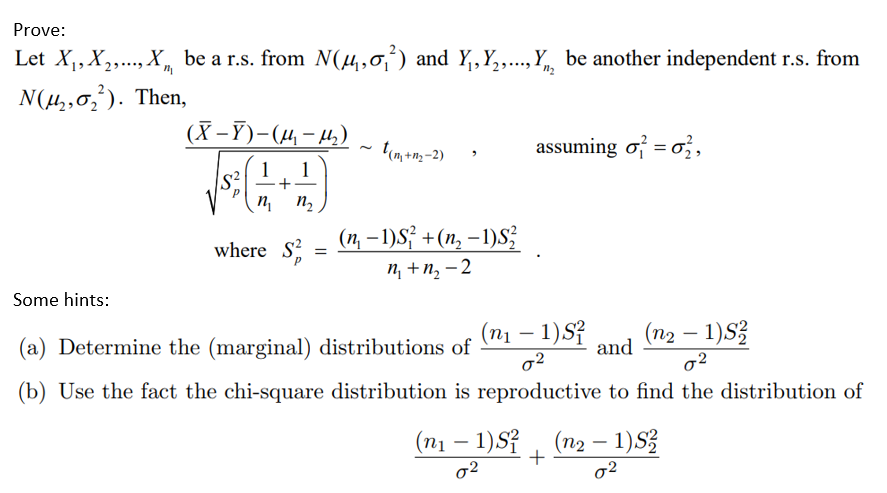Prove: Let X₁, X₂,..., X„ be a r.s. from N(µ,σ²) and Y₁,Y,₂,..., Y be another independent r.s. from N(μ₂,₂²). Then, (X-Ỹ)-(μ₁ −μ₂) t(n₁+n₂-2) assuming o = 2, 1 1 m M₂ where S = (n − 1)S² + (n₂ −1)² m₂ +1₂-2 Some hints: (n₁ - 1)S (n2 - 1)S2 (a) Determine the (marginal) distributions of and 02 02 (b) Use the fact the chi-square distribution is reproductive to find the distribution of (n₁ - 1) S² 02 (n₂ - 1)S2 + 02 ·+·
Prove: Let X₁, X₂,..., X„ be a r.s. from N(µ,σ²) and Y₁,Y,₂,..., Y be another independent r.s. from N(μ₂,₂²). Then, (X-Ỹ)-(μ₁ −μ₂) t(n₁+n₂-2) assuming o = 2, 1 1 m M₂ where S = (n − 1)S² + (n₂ −1)² m₂ +1₂-2 Some hints: (n₁ - 1)S (n2 - 1)S2 (a) Determine the (marginal) distributions of and 02 02 (b) Use the fact the chi-square distribution is reproductive to find the distribution of (n₁ - 1) S² 02 (n₂ - 1)S2 + 02 ·+·
Algebra & Trigonometry with Analytic Geometry
13th Edition
ISBN:9781133382119
Author:Swokowski
Publisher:Swokowski
Chapter9: Systems Of Equations And Inequalities
Section: Chapter Questions
Problem 12T
Related questions
Question

Transcribed Image Text:Prove:
Let X₁, X₂,..., X be a r.s. from N(µ,σ²) and Y₁,Y₂,...,Y be another independent r.s. from
n₁
N(μ₂,02³). Then,
(X-Ỹ)-(μ-μ₂)
t(n+n₂-2)
assuming of = 2,
1
1
+
P
m M₂
where S
=
(n − 1)S² + (n₂ −1)S²
n+n,-2
Some hints:
(n₁ − 1) S²
(a) Determine the (marginal) distributions of
and
(n₂ - 1)S2/
02
02
(b) Use the fact the chi-square distribution is reproductive to find the distribution of
(n₁ − 1)S² (n₂ - 1)S²/
-
+
02
02
Expert Solution
This question has been solved!
Explore an expertly crafted, step-by-step solution for a thorough understanding of key concepts.
Step by step
Solved in 2 steps

Recommended textbooks for you

Algebra & Trigonometry with Analytic Geometry
Algebra
ISBN:
9781133382119
Author:
Swokowski
Publisher:
Cengage

Algebra & Trigonometry with Analytic Geometry
Algebra
ISBN:
9781133382119
Author:
Swokowski
Publisher:
Cengage